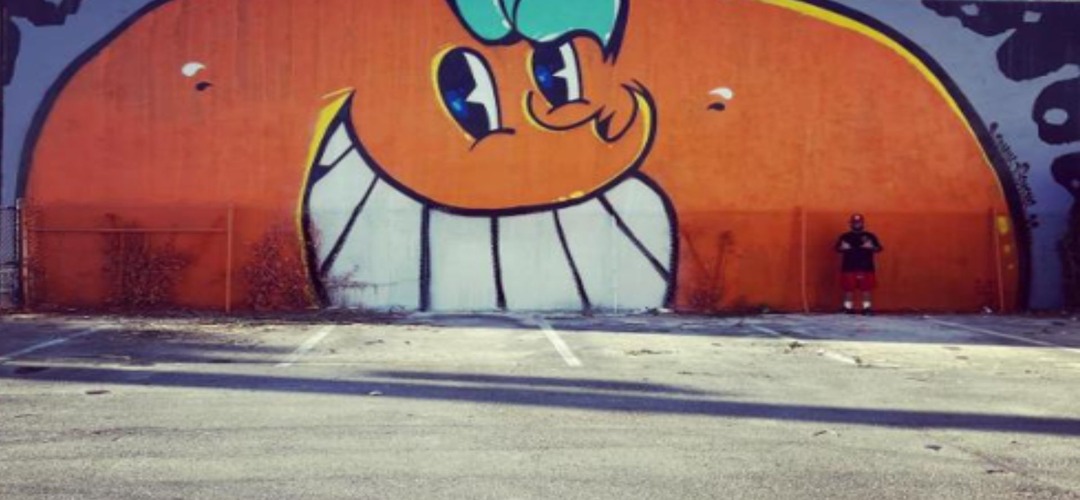
While traveling in Miami in mid-June, I visited the Wynwood district. What I would come to see was graffiti art that piqued my interest and captivated my attention. Among the greatest art present was that of Atomik, the Miami-based graffiti artist leaving his mark on the city and world.
Before colorful murals, graffiti museums, art galleries, and chic boutiques coming in, Wynwood was in fact a struggling working-class neighborhood with burgeoning crime and riots in the 80s.
Walking down the streets in Wynwood, I saw different kinds of graffiti. Each piece emanated a strong personality of its creator.
One piece stood out; a bright orange graffiti instantly caught my attention. I couldn’t stop thinking about the adorable orange head, the cartoony eyes, the exaggerated smile with a chipped tooth, and even the stem popping out at the top of its head.

The neighborhood has greatly changed over the past decades. As the Design District to the north became insanely expensive, art crowd and developers were attracted to Wynwood’s lower rents and ample warehouses. That was when the gentrification began. The incoming talented artists have transformed Wynwood into a newly rising creative community.
The funny-looking smiling orange character was omnipresent in Miami. I later learned that it was local graffiti artist Atomik’s work.

Atomik, the Miami-based graffiti artist

Hailing from a graphic design background, Atomik is a huge influence in the Miami art scene.
Atomik’s real name is Adam Paul Vargas. He was born in 1981 and grew up in South Florida’s suburban Kendall neighborhood in Miami-Dade County.
Atomik has shown tremendous interest in graffiti art since a young age. The Miami-based graffiti artist’s first graffiti was during elementary school, during which he used the tag name APV, initials to his full name.
Throughout middle school and high school, Atomik continued to practice graffiti and has since left his mark everywhere in the city. At age 15, a friend gave him the tag name, Atom. He adapted the name to Atomik two years later.
In 2003, Atomik joined Miami Style Gods (MSG), a graffiti crew founded in the early 90s. He and some friends established a new crew, 28, two years later. 28 is a nod to Miami-Dade County’s police dispatch code for vandalism.
Origin of the iconic orange character

The idea of the orange character came from the Miami Orange Bowl. The original design resembled very much to the 1989 version of the Orange Bowl mascot, Obie.
The Orange Bowl has always had a special place in Atomik’s heart. To Atomik, it was a sacred place for Miami football. He used to go to football games and other events there before the landmark was demolished in 2008. Painting the orange character out in the public was the artist’s way to memorize the absent architecture.
His open devotion to the painting of the orange character, however, did not receive good response from The Orange Bowl Committee. The organization sent the artist a cease-and-desist order to stop using the Obie in his arts. Instead of giving up the design, however, Atomik made a couple adaptations.
The orange is still there, but its crown is replaced with a stem, a teardrop is placed on the side of its face. Its big smile, additionally, is accentuated more with a later added chipped tooth. Meanwhile, Obie’s original nose-to lip connection and Pacman eyes remain.
The orange is now Atomik’s trademark and style. Many people can relate to the orange not only because it is a signature mascot of Florida, but also because it reminds them of their memories and experiences with the Orange Bowl.
The legend of the Miami graffiti artist continues
Atomik’s art has accumulated considerable recognitions from both the art community and the public throughout the years. However, it was in 2012 that his work has been made ‘legit’ and professionally recognized.
During the time, Atomik was asked to create a mural with the words ‘Welcome you to Little Havana’ on Calle Ocho. It was a big mural that featured dominos and other symbols of the neighborhood.
The representative Cuban cigars, however, were absent. The program received sponsorship from Preferred Care Partners, Medica HealthCare Plans and AARP Medicare Plans from UnitedHealthcare.

It’s the 24th year this year since Atomik first started doing spray can art. Over the past two decades, he travelled to Chile, Peru, Colombia, Brazil, Argentina, Mexico, Holland, Germany, Italy, Spain, England, Australia, Korea, Thailand, and so on. His signature orange character, too, travelled along with him and found its place in those locations.
Travel generates creativity and motivation
It could be hard to be creative in Miami sometimes, as the artist has been painting there for over two decades. Therefore, he would travel to different cities and countries. In new places, he gains inspirations again and spreads his work.
As he comments in an interview with Juxtapoz, “Traveling charges my creativity and motivates me to paint once I return.”
Traveling opens up a lot of doors and opportunities for him. Mobility influences the delivery of his art and application.
With repetition comes perfection
Does Atomik ever get tired of painting the orange over and over? Maybe.

To the artist, the repetition can get boring from time to time, but it is an addiction to him. Through repeatedly producing the same subject, he refines his artistic skill and style.
What will Atomik impress the world with next time? A vinyl toy or a new collaboration with brands of the orange? Maybe when you travel to a new place next time, you will run into the artist and be fortunate enough to witness the birth of another signature orange character!










